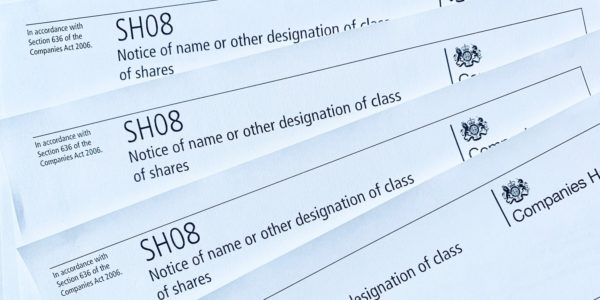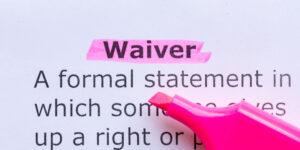A redesignation of shares is the process of converting issued shares in a company from one class (type) to another, e.g. converting ordinary shares to alphabet shares. Often referred to as a ‘reclassification of shares’, companies will carry out this procedure for various reasons, such as altering shareholders’ dividends or voting rights.
We’ll take a look at the most common reasons below, before outlining the requirements and procedure you need to follow to redesignate shares in a private company limited by shares in the UK.
What is a redesignation of shares?
During the life of your company, it may be necessary to alter its share structure at some point. Aside from creating new shares or reducing share capital, you can do this by making changes to the company’s existing issued shares.
This process is most commonly referred to as a ‘redesignation’, ’reclassification’, or ‘renaming’ of shares. It involves converting issued shares from their existing class, i.e. ‘type’ or ‘classification’, to a different one.
Since most companies are set up with only ‘ordinary’ shares, it is often necessary to convert some or all of these shares to different classes as the business develops.
Ordinary shares are the go-to class because they carry equal voting, dividend, and capital rights. However, whilst the simplicity of this share structure can be of benefit to startups and small companies, having only one class of share can be a hindrance to larger companies and those with multiple shareholders.
- A guide to company shares
- What are my shareholder rights?
- How many shares should I issue when I forming a company?
In these situations, reclassification of shares enables a company to alter the rights of different shareholders, without the need to issue additional shares. These rights, which are referred to as the ‘prescribed particulars’, are attached to shares in accordance with their assigned classification.
Why would a company redesignate shares?
There are several reasons why a company would choose to carry out a redesignation of shares, such as:
- Providing additional or preferential dividend rights to certain members, e.g. to ensure the founding shareholders or major investors receive dividend payments before any other members
- Offering shares to employees, children, or family members without relinquishing control of the business, e.g. by issuing shares that provide the benefit of dividends but no right to vote on company decisions
- Ensuring the original shareholders maintain greater control than other members or new investors, e.g. varying voting rights by converting ordinary shares to alphabet shares or non-voting shares
- Providing preferential capital rights to shareholders who invest the greatest amount of money in the business
- Attracting new investors by offering fixed dividends, rather than a distribution of profits based on the percentage of ownership represented by a member’s shareholdings
- Removing voting rights from inherited shares upon the death of a shareholder
- Restricting voting rights of a director-shareholder when they retire
- Restructuring the business upon the sale of the company
- Improving tax planning and tax efficiency, e.g. minimising a shareholder’s personal tax liability by taking advantage of their annual tax-free dividend allowance and lower rates of dividend tax
By converting existing shares from one class to another, a company can adjust the rights of different shareholders as and when the need arises, without increasing the total number of shares in issue.
How to redesignate shares – a step-by-step process
In accordance with section 636 of the Companies Act 2006, a limited by shares company can redesignate shares by following these five simple steps below.
Step 1: Check the articles of association
Whatever the reason for redesignating shares, the directors must check that the company’s articles of association:
- provide for different share classes
- set out the prescribed particulars of rights attached to each class
- specify the particular procedure for converting shares
- do not include any restrictions that may prohibit the redesignation
If the articles do not provide for different types of shares other than ordinary, you will need to pass a special resolution of the members to alter the articles accordingly.
This type of resolution can be passed in writing or at a general meeting with the approval of at least 75% of shareholder votes.
If you make any such changes, a copy of the resolution and the amended articles must be filed at Companies House within 15 days.
Step 2. Pass an ordinary resolution of the members
When you have altered the articles (where relevant), you can carry out a redesignation of shares by passing an ordinary resolution of members, either in writing or at a general meeting.
This type of resolution requires a simple majority (greater than 50%) of members’ votes to pass.
However, some companies may include a provision in their articles specifying that a higher majority or unanimous agreement is required to reclassify shares.
Step 3. Complete and file Companies House form SH08
Upon passing the resolution, the directors must complete form SH08 – Notice of name or other designation of class of shares with the following details:
- Company registration number
- Company name in full
- The date on which the redesignation took place
- The class originally assigned to the share(s)
- The class of share(s) after redesignation
You must file this form at Companies House, either online or by post, within one month of the redesignation. Companies House will record the information on the public register, along with a copy of form SH08.
Step 4. Update the register of members and PSC register
Following a redesignation of shares, the director is required to update the company’s statutory register of members accordingly. This should happen as soon as possible after any redesignation of shares.
- How to look after your statutory registers
- A guide to the Register of People with Significant Control (PSC)
If a shareholder’s nature of control in the company has changed as a result of the new share designation, it may also be necessary to enter or update their details on the register of people with significant control (PSC register).
Step 5. Issue new share certificates
New share certificates should be issued to the affected members, to reflect the changes made to their share classes. The same members must also return their original share certificates to the company.
Need help converting your company shares?
Whilst the redesignation procedure itself is relatively straightforward, deciding on the most appropriate share structure for your company can be a complex affair.
If you are considering a redesignation of shares in a private company limited by shares, our company secretarial team can help you every step of the way.
1st Formations Redesignation of Shares Service provides expert guidance, alongside the processing and completion of all supporting documentation required to convert your company shares.
To find out more about this service, please contact our specialist CoSec team today on 0203 984 5387, or email us at cosec@1stformations.co.uk.
Please note that the information provided in this article is for general informational purposes only and does not constitute legal, tax, or professional advice. While our aim is that the content is accurate and up to date, it should not be relied upon as a substitute for tailored advice from qualified professionals. We strongly recommend that you seek independent legal and tax advice specific to your circumstances before acting on any information contained in this article. We accept no responsibility or liability for any loss or damage that may result from your reliance on the information provided in this article. Use of the information contained in this article is entirely at your own risk.












Join The Discussion